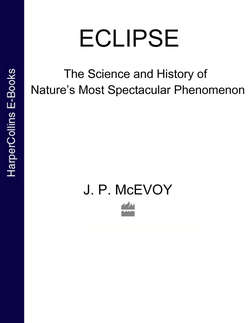Читать книгу Eclipse: The science and history of nature's most spectacular phenomenon - J. McEvoy P. - Страница 10
APPARENT MOTION OF THE SUN AND THE MOON: THE CELESTIAL SPHERE
ОглавлениеSuppose a sphere that contains the whole universe is drawn with the Earth as its centre, as shown in Figure 1.1. The outer shell is an imaginary infinitely large dome onto which the positions of the stars and all other celestial bodies are projected. At any one time, we can see only half of this sphere from our position on the Earth. The celestial sphere works as a model because we are interested only in the directions of celestial bodies, not their distances from the Earth. The celestial equator is a projection of the Earth’s equator onto the sphere. Directly above the Earth’s north geographical pole is the north pole star, Polaris, marking the position of the north celestial pole. This star appears stationary in the sky as the other stars appear to revolve around it because the axis of the Earth’s rotation passes through it. (It is actually nearly a degree from the north celestial pole itself, but this is close enough for it to appear more or less fixed.) Instead of the Earth’s rotating in one direction, the sphere is imagined to turn in the opposite direction once every 24 hours so that all the stars complete one cycle every day. This simulates what we see from the apparently stationary Earth.
The Sun moves around the celestial sphere on a path called the ecliptic, describing a complete 360° circuit at a rate of approximately 1° per day in its annual cycle of 365 days. The Moon’s path on the celestial sphere differs distinctly from the Sun’s. First, the Moon moves more swiftly than the Sun, completing a circuit of the celestial sphere in 29.5 days as seen from the Earth. Second, the Moon’s orbit has a different orientation from the Sun’s, intersecting the ecliptic at an angle of about 5°, as shown in Figure 1.1. The intersections of the paths of the Sun and the Moon defines two points on the ecliptic called the nodes of the Moon’s orbit. The nodes, denoted by the letter N in Figure 1.1, are crucial to the study of eclipses. The arrows showing the direction of the orbital motion of the Moon indicate that one node, N1, is the descending node, where the Moon crosses the celestial equator from north to south. The other node, N2, is the ascending node, where the Moon crosses the celestial equator from south to north.
Figure 1.1. The celestial sphere, showing the paths of the Sun and Moon and the position of the lunar nodes.
To study eclipses, it is necessary to consider the motion of the Sun and the Moon simultaneously. The Sun advances about 1° per day along the ecliptic, and the Moon moves in the same direction at about 12° per day along its orbital path. As the Moon completes a circuit of the celestial sphere about twelve times faster than the Sun, the Moon is always catching the Sun up and passing it.
With the celestial sphere defined and understood, all aspects of the apparent motion of the Sun and Moon necessary to describe eclipses are in place. However, it should be kept in mind that though this model may be useful, it is of course not a true picture of nature. The Sun does not move around the Earth. In fact, the opposite is true. Nevertheless, the celestial sphere model shows the sky as it appears to an observer on the Earth. So it is possible to speak of the ‘Sun orbiting the Earth’ in terms of the celestial sphere. The model allows us to define the positions of celestial bodies, and greatly simplifies the visualisation of their motion. It is used by astronomers the world over to measure and report observations of Sun and Moon, planets and stars. During the eighteenth century celestial globes based on the celestial-sphere model were popular accessories among the upper classes. Definitely de rigueur in fashionable British and European salons.
A solar eclipse happens when the Moon moves into alignment between the Sun and the Earth, casting its shadow on the Earth and blocking off the Sun’s light. Alternatively, if the Moon moves into alignment with the Sun but behind the Earth, the Earth’s shadow falls on the Moon. This is called a lunar eclipse. If the orbits of the Sun and the Moon were in the same plane, a solar eclipse would occur at every new Moon and a lunar eclipse would occur at every full Moon. This doesn’t happen because the orbit of the Moon is inclined at 5° to the orbit of the Earth around the Sun, as shown in Figure 1.1. The conditions for an eclipse to occur are that the Moon must be new or full and close to one of the nodes. If the new Moon is close to a node, a solar eclipse may occur; if the full Moon is close to a node, a lunar eclipse may occur. As we shall see, the proximity of the Moon to a node is critical. But first, we shall look more closely at the changing phase of the Moon as it moves in its orbit, and the relation of this to eclipses.
Figure 1.2. ‘The First Lecture in Geography and Astronomy’, 1748, based on the celestial-sphere model of the sky.
Hulton Getty, London
